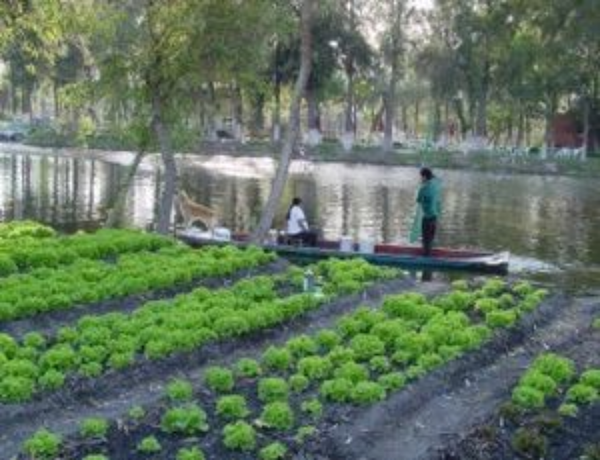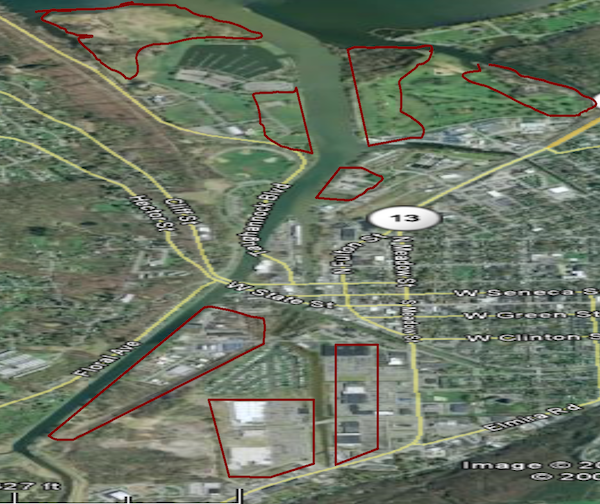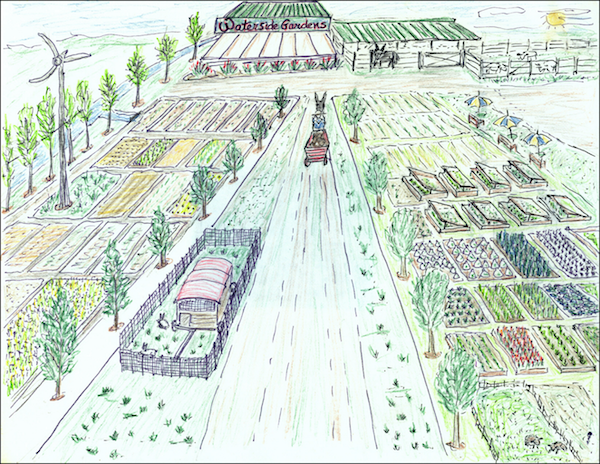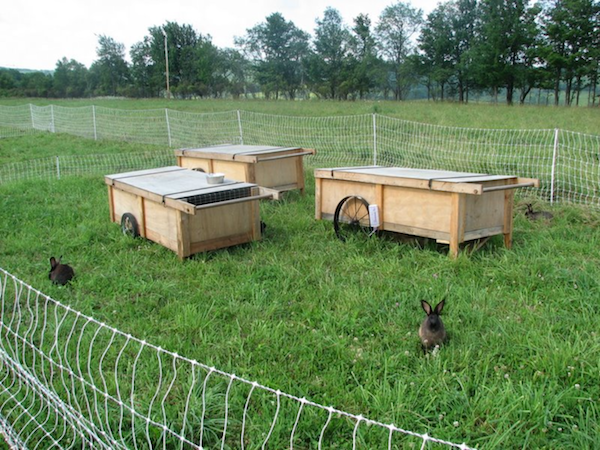urban: June 2010 Archives
by Karl North
This series of articles is an exploration of designs for agriculture in Tompkins County to approach sustainability in a future of declining access to the cheap energy and other inputs on which our industrialized food system relies. In earlier parts of this series, I proposed principles of agroecosystem design; addressed the key issues of fertility, energy, water, and pest control; and pictured the future county food system as a whole, including its historical context, implications, and the interdependencies among the parts that will make them most effective as an integrated system. I said that providing for the local food needs of urban populations requires a design that integrates three overlapping categories of production systems: urban agriculture systems (many small islands of gardening in the city center), peri-urban agriculture (larger production areas on the immediate periphery), and rural agriculture (feeder farms associated with village-size population clusters in the hinterland of the city but close enough to be satellite hamlets).
In this month's article I will consider the needs and resources that will shape the design of peri-urban agriculture systems around the city of Ithaca, and offer a case study as a design example.
Figure 1. Cooperative farms on the edge of Havana, Cuba
Cities are often ringed with suburbs, parks, and industrial and commercial zones that can be converted to larger, more integrated agricultural systems than densely populated urban neighborhoods (Figure 1). Deer and rodents have proliferated in the urban-suburban boundaries that are excellent edge habitats for these species. Agriculture in these areas will need to achieve deer and rodent control by fencing that is effective against jumping and burrowing and by regulated trapping for meat and hides to eventually reduce populations.
The best candidates for conversion to farming are sites that have good soil and water resources yet are close enough for easy access by urban consumers and potential farm labor. Two such areas on the periphery of Ithaca are the flood plain beside the lake and inlet and the nearest locations on the main existing transport routes, particularly those with existing rail lines, north up the east edge of the lake and south along route 13.
The flood plain
One-sixth of 19th-century Paris was devoted to intensive urban gardens, prominently in the Marais (wetland) on the right bank of the Seine River. Fueled by manure from the city's thousands of working horses, peri-urban gardens fed Parisians with greens, vegetables, and fruits the year around. The history of a similar district on the edge of climatically similar Ithaca indicates its food production potential. This neighborhood was once home to a distinctive waterside community of fisher-farmers who, despite their lower socio-economic status compared to some Ithacans, were able to achieve relative self-sufficiency on the rich alluvial soils and aquatic resources of their neighborhood.
Ithaca has a unique resource in these lakeside and inlet soils. They are potentially the most productive agricultural land in the county when converted to the chinampa-style systems described in Part Two (Figure 2).
Figure 2. Mexico City chinampas
Some of this land may now be “brown fields” of soils that are polluted from years of commercial and industrial use but can be reclaimed biologically. Bioremediation can take various forms. Several years of intensive grazing and repeated trash plowing and replanting of grass cover not only builds soil organic matter rapidly but cleanses it as well by bacterial action as the soils become more biologically active. Instead of normal plowing that buries sod, trash plowing upends it for fast aerobic decomposition. If this is insufficient, raised beds with imported soil are a solution that has worked in many urban locations.
Land use policy for the district would have to change to reflect the food production priorities of the energy descent. Some lands now dedicated to industry, the commercial strip of big box stores, and parts of parks and the golf course will be acknowledged as prime farmland. Figure 3 illustrates examples of potential waterside farm sites.
Figure 3. Examples of potential waterside farm sites on the edge of Ithaca
The politics of conversion of water-side lands to prime food production sites will require a new mindset. Agriculture may be the best use of some of the land now devoted to recreational activities like sailing, picnicking, and golf. Consumers accustomed to shopping in national chain stores will need to learn that they represent what Wendell Berry in The Unsettling of America called an extractive, colonial economy. This economy transfers wealth to metropolitan centers of power from rural peripheries and operates at many scales, from impoverished banana republics like Nicaragua, to shrunken agricultural towns in Nebraska, to the depressed areas of upstate New York. Thus the national chain stores that ring the Ithaca periphery are economic “monocultures” that strip economic wealth from the county just as agricultural monocultures drain fertility from the soil.
Transport route locations
Conversion to more sustainable food production requires more people living closer to food production in order to provide labor and to facilitate nutrient recycling. Energy descent writer Richard Heinberg estimates the need for 50 million farmers in the U.S., up from 2 million today.[1] In a similar assessment, Swedish systems ecologist Folke Günther estimates that the rural farming population needed to support an urban community should be 12 times the urban population. The starting point in our case is a county population of 100,000, of which 30,000 is urban. To achieve the necessary balance, Günther suggests relocation of some urban and close suburban populations to clustered housing in satellite farming villages[2] as older urban housing is replaced by urban gardens. The most economical location for some of these peripheral ecovillages might be in the peri-urban agricultural district along the main transport routes near the city.
Ideally this process would be part of a general physical redesign of both the urban and hinterland communities according to the model that emerged in Europe, where centuries of higher population densities have dictated more careful land use planning. Even today, European towns large and small are characteristically dense clusters of buildings that end abruptly in agrarian vistas.
Visioning a peri-urban case: Waterside Gardens
Commercial strips and malls that typify the urban edge, vacated in the shrinking national economy, are prime candidates for a public takeover that would convert their parking lots to agriculture and the empty buildings to farming and related community uses. To exemplify this conversion, we will envision a farm operated as a commercial cooperative, using a future abandoned Wegmans waterside parking lot and supermarket building (one of the locations outlined in Figure 3). Let's call our imaginary cooperative “Waterside Gardens” (Figure 4).
Figure 4. Waterside Gardens (artist's conception by Jane North)
A policy framework. The dirty little secret of small farms is that they don't make much of a profit in competition with industrialized agriculture. A food policy framework guarantees the economic viability of Waterside Gardens:
- As part of a county-wide green belt policy to stop and convert urban sprawl, the city has remunicipalized most of the inlet area from the lake front to Buttermilk Falls, providing a free lease to co-ops like this one as long as they continue to build food security and food sovereignty in the county.
- In the wake of widespread demand for local food sovereignty, the country has revised the Constitution. As part of a growing reliance on local, county-wide economic policy making, a tariff is now levied on food coming into the county based on food miles and the ability of local agriculture to provide the product.
- A trolley stop on the public light rail line serves the site to bring agricultural inputs to the co-op and consumers to its retail food market.
Models of ecological health and productivity. Waterside Gardens incorporates two highly productive models of small-scale agriculture that have proved themselves to be effective historically in peri-urban agriculture: chinampa-style canal-side gardens (Mexico city)[3] and the French intensive market garden (Paris).[4]
In the gardens that use the inlet directly, hydrologically controlled subcanals between garden beds divert water from the adjacent inlet canal. These alternating strips of water and land crops are managed to make the system highly productive in several ways:
- Constant sub-irrigation of the growing beds;
- Aquaculture production from a self-feeding, integrated system of water plants and animals;
- Surplus fertility from the aquatic system in the form of muck dredged periodically from the canals for the adjacent bed soils;
- Temperature stabilization from the waterways that improves daily crop growth and extends the growing season.
Farther from the water lie the frame and cloche beds characteristic of the French intensive method. Despite the development of biomass-based plastics, competition from higher priority biomass uses like food and heat has prompted a return to the French tradition of glass for frame covers and the bell-shaped cloches that create the microclimates to protect beds and individual plants.
Windmills pump canal water into raised tanks to provide a constant reserve of gravity-fed irrigation water. Adjacent ponds capture and biocleanse storm water that runs off the city's hills, constituting a water reserve that makes the system resilient to drought.
Another input essential to the intensive method is a constant and copious supply of fresh manure that is placed under and around frames and cloches to maintain growing temperatures in these all-season gardens. Initially the only manure source was the small population of livestock that peri-urban production systems can integrate. However, diminishing supplies of fossil fuel and limited supplies of local fuels like biogas from municipal black water processing have driven local transportation partially to rely on animal power. A growing mule population now transports people and produce around the county, much of it efficiently on the rebuilt light rail network. Like other peri-urban farms, this one provides stables for some of the mule contingent in return for the steady supply of hot manure. Their hay is transported by water directly into docks at the garden site from farms around the lake.
Wind protection is part of the intensive gardening system. The old supermarket and the high hedges on the northeast and northwest edges stop the coldest prevailing winds, and low walls throughout the gardens reduce wind at plant level while letting in sun.
While much of the French system is possible in urban agriculture, peri-urban spaces allow its full development as it originally functioned on the outskirts of Paris. This is because its year-round production requires quantities of hot manure as well as the constant attention of full-time gardeners highly skilled in the careful timing of watering, frame and cloche ventilation, and protection of frames from sun and cold. This garden recaptures the full knowledge- and management-intensive qualities that made the Paris market garden system so successful.
A more extensive system. The co-op includes a third, more extensive gardening system to grow crops like roots and tubers that need more space and to integrate small animal production. To fertilize this garden, the co-op manages a facility in which pig turners enhance the vermicomposting of part of the city's segregated organic waste stream.
Originally judged a brownfield, the soil of this part of the market garden spent its first years of conversion to agricultural quality under intensive grazing alternated with heavy applications of compost seeded with fast growing forages in the cleansing process described earlier. Now it consists of beds long enough to be worked by some of the mules housed in the co-op and grassed alleys wide enough to permit farm vehicles and grazing with rabbits and poultry in movable pens, as illustrated in Figure 5. In season, the rabbits thrive on an all-grass diet, and feed for the poultry is supplemented with part of the garbage and worms from compost production. The alleys are lined with composting sheds to which the poultry have access as their grazing pens are moved along the alleys. In all seasons the pigs, poultry, and rabbits consume the co-op's garden waste as one of their roles in the system.
Figure 5. Grass-fed rabbit production at Northland Sheep Dairy, a farm near Tompkins County
The old supermarket now serves many new functions. In addition to the stables, it houses farm tools and machines and harvest and feed storage areas. It also includes community centers to market products from adjacent community gardens, train new farmers, and house full-time farm workers and food processing centers. The south front is a passive solar greenhouse that heats the building and grows vegetable and nursery transplants for the rest of the farm.
Boundaries of the tripartite farm as well as individual beds are specifically designed for multiple functions. They include habitats that attract beneficials and trap pests before they reach food plants; bird and bat houses; flowering plants to attract pollinators; food bearing bushes, trees, and trellises that act as shelter belts against wind and sun; and walkways and benches to function as a parkland that brings urban residents into contact with the gardens.
As with much of peri-urban agriculture, the size of this co-op creates heavier seasonal labor needs than city gardens. With a large city population close at hand, however, it manages to attract enough seasonal workers by paying them with credits they can use when they purchase the food products of the enterprise.
Notes
[1] http://www.energybulletin.net/node/22584
[2] http://www.holon.se/folke/lectures/Ruralisation-filer/v3_document.htm
[3] http://en.wikipedia.org/wiki/Chinampa
[4] Weathers, John. 1909. French Market Gardening. http://ia331426.us.archive.org/3/items/frenchmarketgard00weatrich/frenchmarketgard00weatrich.pdf





